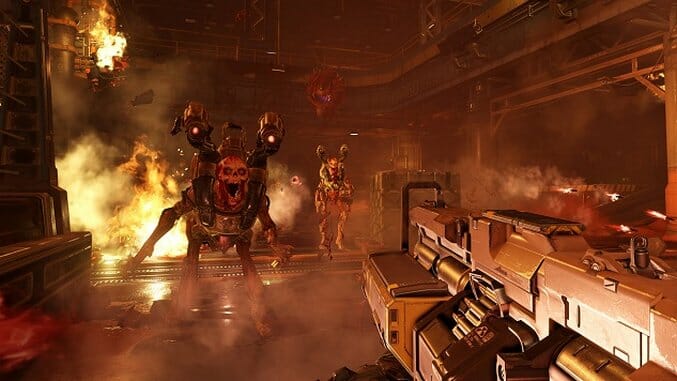The New DOOM Feels Like Coming Home

Within the microcosm of games, success breeds institution—games that sell well are elevated to monolithic, recurring fixtures. But DOOM has always been sacrosanct and immutable. The first major sequel didn’t come until more than 10 years after DOOM’s initial release. DOOM 3 had the unenviable challenge of trying to forcibly drag into the modern age a game that had been unchanged since before there was a Playstation. DOOM 3 was a failure. But its most enduring legacy is that it demonstrated that a game with DOOM’s sensibilities can’t exist in today’s shooter ecosystem.
The new DOOM is a Good Videogame. More impressively than that, it’s a good DOOM game. Worth noting up front is that this is DOOM, not DOOM 4; id Software is clearly no longer content to iterate. Only a total return to the source will do. And shockingly, that’s exactly what they do with DOOM (2016).
The glory of the ‘93 game is that it is incredibly experiential. It was one of the first videogames focused on making players feel a certain way rather than merely giving them obstacles to overcome. Everything about DOOM served its mood, from the dynamic lighting to the increasingly chaotic and disorienting levels as players progressed deeper and deeper into Hell. Players weren’t just navigating DoomGuy, they were DoomGuy. Sadly, the past decade or so has seen developers largely move away from this type of experiential-based design, trading in relatability for #content, foregoing risky innovation for safe (but field-tested) iteration.
But you have to burn down the old growth before new life can be planted. For DOOM (2016), developers id Software internalized this maxim. Unlike DOOM 3, which was built to be a viable 2004-era shooter, DOOM was built from the ground up with one goal: To revitalize the original game and recapture that experiential feeling.
DOOM is synonymous with speed and momentum. The series’ strength has never been dry writing or thoughtful narrative. From the very outset of the 1993 shooter it’s just you, a gun, and things to kill. DOOM (2016) opens in a similar way: The player, a gun, and demons. In fact, DOOM (2016) may have one of the lowest time-to-gun scores of any recent game. While DOOM 3 spent its opening dozen or so minutes establishing tone and mood with dialogue and narration, DOOM (2016) prefers to let the guns do the talking. Any story that hinges on Hellspawn invading a military base on a Martian moon can only ever be taken well-salted, and this is something even the writers of the game are aware of. From the moment I checked a computer console that read “Demonic Invasion In Progress,” I was hooked.
Sequels, like any adaptation, shouldn’t be mimetic endeavors, but rather interpretive ones. Recreating the exact look and sound of the original source material 1:1 is less desirable than preserving the feel and tone of a game using the mechanics and tools of the day to convey the same message. This is by far DOOM (2016)’s greatest triumph. Mobility has always been the player’s most potent weapon in DOOM. Id faced an enormous challenge trying to bring that sense of motion and kinetics into a 3D space—the original DOOM engine was entirely 2D and incapable of rendering multi-level environments—without slowing things down. The game maintains the breakneck pace of its progenitor while also adding verticality to the mix. The player can now jump, grab ledges and fall great distances. It may seem simple, but it’s the single most important thing about the game.
-

-

-

-

-

-

-

-

-

-

-

-

-

-

-

-

-

-

-

-

-

-

-

-

-

-

-

-

-

-

-

-

-

-

-

-

-

-

-

-









































